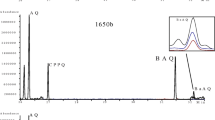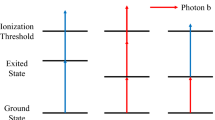Abstract
The development of a unique analytical method for the determination of five classes of persistent organic pollutants (POPs) in atmospheric gas and the particle phase through gas chromatography coupled to high-resolution mass spectrometry is presented. Every step of the pre-analytical and analytical optimization process is described. Great effort was put into simplifying the traditional techniques, with reference to EPA and literature methods. Automated instruments were used for sample extraction and cleanup in order to enhance repeatability and reduce contamination risks. Unlike most common approaches, no separation of the analytes was performed before the GC analysis in order to avoid sample fractionation and to save time and materials. This allowed low instrumental and method detection limits (pg to sub-pg) to be achieved. Accuracy and precision were tested by fortifying the matrix and analysing standard reference materials (NIST SRM 1649b Urban Dust and 2585 Organic Contaminants in House Dust). The method was applied to five samples from Terra Nova Bay, Antarctica. Concentrations of polychlorinated dibenzo-p-dioxins and furans (PCDD/Fs), polychlorinated biphenyls (PCBs), polychlorinated naphthalenes (PCNs), polybrominated diphenyl ethers (PBDEs) and polycyclic aromatic hydrocarbons (PAHs) are presented. Lighter compounds dominate the distribution and are mainly present in the gaseous phase. The observed pattern may be attributable to long-range transport. Results are in general agreement with literature data, where available.



Similar content being viewed by others
References
Van den Berg M, Birnbaum LS, Denison M, De Vito M, Farland W, Feeley M, Fiedler H, Hakansson H, Hanberg A, Haws L, Rose M, Safe S, Schrenk D, Tohyama C, Tritscher A, Tuomisto J, Tysklind M, Walker N, Peterson RE (2006) The 2005 World Health Organization reevaluation of human and mammalian toxic equivalency factors for dioxins and dioxin-like compounds. Toxicol Sci 93(2):223–241
Safe S (2003) Toxicology and risk assessment of POPs. In: Fiedler H (ed) Persistent organic pollutants, vol. 3O. The handbook of environmental chemistry. Springer, Berlin Heidelberg, p 495
Buccini J (2003) The development of a global treaty on persistent organic pollutants (POPs). In: Fiedler H (ed) Persistent organic pollutants, vol. 3O. The handbook of environmental chemistry. Springer, Berlin Heidelberg, pp 13–30
Scheringer M (2009) Long-range transport of organic chemicals in the environment. Environ Toxicol Chem 28(4):677–690
Pozo K, Harner T, Wania F, Muir DCG, Jones KC, Barrie LA (2006) Toward a global network for persistent organic pollutants in air: results from the GAPS study. Environ Sci Technol 40(16):4867–4873
Wania F, Mackay D (1993) Global fractionation and cold condensation of low volatility organochlorine compounds in polar regions. Ambio 22(1):10–18
Wania F, Mackay D (1996) Tracking the distribution of persistent organic pollutants. Environ Sci Technol 30(9):390–396
UNEP (2009) Stockholm convention on persistent organic pollutants (POPs) as amended in 2009
UNECE (1998) Protocol to the 1979 convention on long-range transboundary air pollution on persistent organic pollutants
EPA (2011) Priority pollutants
Alaee M, Arias P, Sjödin A (2003) An overview of commercially used brominated flame retardants, their applications, their use patterns in different countries/regions and possible modes of release. Environ Int 29:683–689
Erickson MD (1997) Analytical chemistry of PCBs. Lewis Publishers, Chelsea
Falandysz J, Kawano M, Ueda M, Matsuda M, Kannan K, Giesy JP, Wakimoto T (2000) Composition of chloronaphthalene congeners in technical chloronaphthalene formulations of the Halowax series. J Environ Sci Health, Part A: Tox Hazard Subst Environ Eng 35(3):281–298
EPA (1999) Compendium of methods for the determination of compounds in ambient air—compendium method TO-9A—determination of polychlorinated, polybrominated and brominated/chlorinated dibenzo-p-dioxins and dibenzofurans in ambient air
Manodori L, Gambaro A, Zangrando R, Turetta C, Cescon P (2006) Polychlorinated naphthalenes in the gas-phase of the Venice Lagoon atmosphere. Atmos Environ 40:2020–2029
Krauss M, Wilcke W (2003) Polychlorinated naphthalenes in urban soils: analysis, concentrations, and relation to other persistent organic pollutants. Environ Pollut 122(1):75–89
Moret I, Piazza R, Benedetti M, Gambaro A, Barbante C, Cescon P (2001) Determination of polychlorobiphenyls in Venice Lagoon sediments. Chemosphere 43(4–7):559–565
IPCS (1993) Benzene. Geneva, World Health Organization, International Programme on Chemical Safety (Environmental Health Criteria 150)
Abad E, Sauló J, Caixach J, Rivera J (2000) Evaluation of a new automated cleanup system for the analysis of polychlorinated dibenzo-p-dioxins and dibenzofurans in environmental samples. J Chromatogr A 893:383–391
Lohmann R, Northcott GL, Jones KC (2000) Assessing the contribution of diffuse domestic burning as a source of PCDD/Fs, PCBs, and PAHs to the U.K. atmosphere. Environ Sci Technol 34(14):2892–2899
Hung H, Blanchard P, Poole G, Thibert B, Chiu CH (2002) Measurement of particle-bound polychlorinated dibenzo-p-dioxins and dibenzofurans (PCDD/Fs) in Arctic air at Alert, Nunavut, Canada. Atmos Environ 36:1041–1050
Piazza R, Giuliani S, Bellucci LG, Mugnai C, Cu NH, Nhon DH, Vecchiato M, Romano S, Frignani M (2010) PCDD/Fs in sediments of Central Vietnam coastal lagoons: in search of TCDD. Mar Pollut Bull 60(12):2303–2310
Gambaro A, Radaelli M, Piazza R, Stortini AM, Contini D, Belosi F, Zangrando R, Cescon P (2009) Organic micropollutants in wet and dry depositions in the Venice Lagoon. Chemosphere 76(8):1017–1022
Turner WE, Cash TP, DiPietro ES, Patterson DG (1998) Evaluation and applications of the power-prep “universal” automated clean-up system for PCDDs, PCDFs, cPCBs, PCB congeners, and chlorinated pesticides in biological samples. Organohalogen Compd 35:21–24
Pirard C, Focant JF, De Pauw E (2002) An improved clean-up strategy for simultaneous analysis of polychlorinated dibenzo-p-dioxins (PCDD), polychlorinated dibenzofurans (PCDF), and polychlorinated biphenyls (PCB) in fatty food samples. Anal Bioanal Chem 372:373–381
Björklund J, Tollbäck P, Hiarne C (2004) Influence of the injection technique and the column system on gas chromatographic determination of polybrominated diphenyl ethers. J Chromatogr A 1041:201–210
Covaci A, Voorspoels S, de Boer J (2003) Determination of brominated flame retardants, with emphasis on polybrominated diphenyl ethers (PBDEs) in environmental and human samples—a review. Environ Int 29:735–756
Taverniers I, De Loose M, Van Bockstaele E (2004) Trends in quality in the analytical laboratory. II. Analytical method validation and quality assurance. TrAC Trends Anal Chem 23(8):535–552
NIST Certificate of Analysis. Standard Reference Material® 1649b. Urban Dust
ISO (2002) Soil quality. Determination of organochlorine pesticides and polychlorinated biphenyls—gas-chromatographic method with electron capture detection. ISO 10328
Kallenborn R, Oehme M, Wynn-Williams DD, Schlabach M, Harris J (1998) Ambient air levels and atmospheric long-range transport of persistent organochlorines to Signy Island, Antarctica. Sci Total Environ 220(2–3):167–180
Gambaro A, Manodori L, Zangrando R, Cincinelli A, Capodaglio G, Cescon P (2005) Atmospheric PCB concentrations at Terra Nova Bay, Antarctica. Environ Sci Technol 39(24):9406–9411
Binelli A, Roscioli C, Guzzella L (2006) Improvements in the analysis of decabromodiphenyl ether using on-column injection and electron-capture detection. J Chromatogr A 1136:243–247
Björklund J, Tollbäck P, Ostman C (2003) Mass spectrometric characteristics of decabromodiphenyl ether and the application of isotopic dilution in the electron capture negative ionization mode for the analysis of polybrominated diphenyl ethers. J Mass Spectrom 38:394–400
Hart KM, Pankow JF (1994) High-volume air sampler for particle and gas sampling. 2. Use of backup filters to correct for the adsorption of gas-phase polycyclic aromatic hydrocarbons to the front filter. Environ Sci Technol 28(4):655–661
Peters AJ, Lane DA, Gundel LA, Northcott GL, Jones KC (2000) A comparison of high volume and diffusion denuder samplers for measuring semivolatile organic compounds in the atmosphere. Environ Sci Technol 34(23):5001–5006
Lohmann R, Ockenden WA, Shears J, Jones KC (2001) Atmospheric distribution of polychlorinated dibenzo-p-dioxins, dibenzofurans (PCDD/Fs), and non-ortho biphenyls (PCBs) along a north–south Atlantic transect. Environ Sci Technol 35(20):4046–4053
Wania F (2003) Assessing the potential of persistent organic chemicals for long-range transport and accumulation in polar regions. Environ Sci Technol 37(7):1344–1351
Li Y, Geng D, Liu F, Wang T, Wang P, Zhang Q, Jiang G (2012) Study of PCBs and PBDEs in King George Island, Antarctica, using PUF passive air sampling. Atmos Environ 51:140–145
Lee S, Harner T, Pozo K, Shoeib M, Wania F, Muir DCG, Barrie LA, Jones KC (2007) Polychlorinated naphthalenes in the global atmospheric passive sampling (GAPS) study. Environ Sci Technol 41(8):2680–2687
Król S, Zabiegala B, Namiesnnik J (2012) PBDEs in environmental samples: sampling and analysis. Talanta 93:1–17
de Wit CA (2002) An overview of brominated flame retardants in the environment. Chemosphere 46:583–624
Yogui GT, Sericano JL (2008) Polybrominated diphenyl ether flame retardants in lichens and mosses from King George Island, maritime Antarctica. Chemosphere 73(10):1589–1593
Caricchia AM, Chiavarini S, Cremisini C, Morabito R, Perini A, Pezza M (1995) Determination of PAH in atmospheric particulates in the area of the Italian base in Antarctica: report on monitoring activities during the last three scientific expeditions. Environ Pollut 87(3):345–356
Castro-Jimènez J, Mariani G, Eisenreich SJ, Christoph EH, Hanke G, Canuti E, Skejo H, Umlauf G (2008) Atmospheric input of POPs into Lake Maggiore (Northern Italy): PCDD/F and dioxin-like PCB profiles and fluxes in the atmosphere and aquatic system. Chemosphere 73(1, Supplement 1):S122–S130
Vives I, Canuti E, Castro-Jimènez J, Cristoph EH, Eisenreich SJ, Hanke G, Huber T, Mariani G, Mueller A, Skeio H, Umlauf G, Wollgast J (2010) Occurrence of polychlorinated dibenzo-p-dioxins and dibenzofurans (PCDD/Fs), polychlorinated biphenyls (PCBs) and polybrominated diphenyl ethers (PBDEs) in Lake Maggiore (Italy and Switzerland). J Environ Monit 9:589–598
Helaleh MIH, Al-Rashdan A, Ibtisam A (2012) Simultaneous analysis of organochlorinated pesticides (OCPs) and polychlorinated biphenyls (PCBs) from marine samples using automated pressurized liquid extraction (PLE) and Power Prep™ clean-up. Talanta 94:44–49
Acknowledgements
This work was supported by the Institute for the Dynamics of Environmental Processes of the National Research Council of Italy (IDPA-CNR) and the Consorzio per l’attuazione del Programma Nazionale per le Ricerche in Antartide (PNRA). We thank Dr. Roberta Zangrando and Dr. Warren Cairns for the scientific and technical support.
Author information
Authors and Affiliations
Corresponding author
Additional information
Published in the special issue Analytical Science in Italy with guest editor Aldo Roda.
Electronic supplementary material
Below is the link to the electronic supplementary material.
ESM 1
(PDF 106 kb)
Rights and permissions
About this article
Cite this article
Piazza, R., Gambaro, A., Argiriadis, E. et al. Development of a method for simultaneous analysis of PCDDs, PCDFs, PCBs, PBDEs, PCNs and PAHs in Antarctic air. Anal Bioanal Chem 405, 917–932 (2013). https://doi.org/10.1007/s00216-012-6464-y
Received:
Revised:
Accepted:
Published:
Issue Date:
DOI: https://doi.org/10.1007/s00216-012-6464-y




